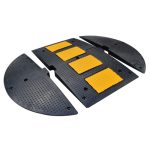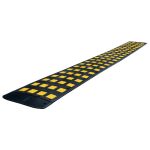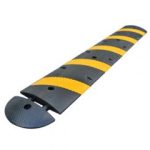Introduction
Importance of school zone safety
School zone safety is of utmost importance in ensuring the well-being of students. With the increasing number of vehicles on the road, it is crucial to implement measures that can effectively control and regulate traffic in these areas. Speed bumps play a vital role in enhancing school zone safety by slowing down vehicles and encouraging drivers to be more cautious. These physical traffic calming devices help create a safer environment for students to cross the road and for pedestrians to navigate the school zone. By reducing vehicle speed, speed bumps contribute to preventing accidents and minimizing the severity of any potential collisions. Therefore, the presence of speed bumps in school zones is essential for promoting the safety and security of students, making them a crucial component of any comprehensive school zone safety plan.
Overview of speed bumps
Speed bumps play a crucial role in enhancing safety in school zones. They are designed to slow down vehicles and ensure that drivers adhere to the designated speed limits. The main purpose of speed bumps is to reduce the risk of accidents and protect pedestrians, especially children, who are often present in school areas. By creating a physical barrier, speed bumps encourage drivers to drive more cautiously, increasing the overall safety of the school zone. Additionally, speed bumps also serve as a visual reminder for drivers to be vigilant and attentive while navigating through these areas. Overall, the presence of speed bumps in school zones contributes significantly to preventing potential accidents and promoting a safer environment for everyone involved.
Purpose of the article
The purpose of this article is to explore the role of speed bumps in enhancing safety within school zones. With the increasing concern for the safety of students, it is crucial to understand the effectiveness of speed bumps in reducing vehicle speeds and preventing accidents. This article aims to examine the benefits and limitations of speed bumps as a traffic calming measure and to provide insights into their implementation and maintenance. By shedding light on the purpose and importance of speed bumps in school zone safety, this article aims to contribute to the ongoing efforts to create safer environments for students.
Benefits of Speed Bumps
Reducing vehicle speed
Reducing vehicle speed is crucial in ensuring the safety of school zones. Speed bumps play a significant role in achieving this objective. By strategically placing speed bumps along the roads leading to schools, drivers are forced to slow down and adhere to the designated speed limits. This not only helps prevent accidents but also provides a safer environment for children to navigate their way to and from school. The presence of speed bumps serves as a visual reminder for drivers to be cautious and attentive while driving through school zones, ultimately reducing the risk of potential collisions. Additionally, speed bumps encourage drivers to be more aware of their surroundings and the presence of pedestrians, further enhancing the overall safety of the school area. Therefore, implementing speed bumps as a measure to reduce vehicle speed is an effective strategy in promoting school zone safety.
Enhancing pedestrian safety
Enhancing pedestrian safety is a crucial aspect of ensuring the well-being of students in school zones. One effective measure that has been widely implemented is the installation of speed bumps. These raised pavement structures are strategically placed in areas with high pedestrian traffic to slow down vehicles and create a safer environment for pedestrians. By forcing drivers to reduce their speed, speed bumps help prevent accidents and encourage drivers to be more cautious and attentive while navigating through school zones. Additionally, speed bumps serve as a visual reminder for drivers to be mindful of their surroundings and prioritize the safety of students. Overall, the presence of speed bumps plays a significant role in enhancing pedestrian safety in school zones and contributes to the overall goal of creating a secure and protected environment for students.
Preventing accidents
Speed bumps play a crucial role in preventing accidents in school zones. By slowing down vehicle speed, they create a safer environment for students and pedestrians. The presence of speed bumps serves as a visual reminder for drivers to exercise caution and be aware of their surroundings. This helps to reduce the risk of collisions and ensures that children can safely cross the road. Additionally, speed bumps also encourage drivers to adhere to the designated speed limit, further enhancing the overall safety of the school zone. Overall, the implementation of speed bumps is an effective measure in preventing accidents and protecting the well-being of everyone in the school community.
Types of Speed Bumps
Traditional speed bumps
Traditional speed bumps are a common feature in school zones and are designed to slow down vehicles and enhance safety. These speed bumps are typically made of asphalt or rubber and are strategically placed along the road to force drivers to reduce their speed. The raised surface of the speed bumps creates a jarring effect when vehicles drive over them, encouraging drivers to drive more cautiously. By implementing traditional speed bumps, schools can effectively control the speed of vehicles passing through the school zone, reducing the risk of accidents and ensuring the safety of students and pedestrians.
Speed humps
Speed humps are an effective traffic calming measure that can greatly contribute to the safety of school zones. These raised sections of pavement are strategically placed to slow down vehicles and encourage drivers to be more cautious. By reducing the speed of vehicles passing through school zones, speed humps help to create a safer environment for students, teachers, and pedestrians. They serve as a visual reminder for drivers to be mindful of their surroundings and to prioritize the safety of those around them. Additionally, speed humps can help to reduce the likelihood of accidents and the severity of injuries in the event of a collision. Overall, the presence of speed humps in school zones plays a crucial role in promoting road safety and protecting the well-being of everyone in the community.
Speed cushions
Speed cushions are a type of traffic calming measure that are commonly used in school zones to enhance safety. These raised platforms are designed to slow down vehicles by creating a series of small bumps that force drivers to reduce their speed. Unlike traditional speed bumps, speed cushions are wider and have spaces in between, allowing larger vehicles such as buses and emergency vehicles to straddle them without causing discomfort or damage. By strategically placing speed cushions in school zones, the risk of accidents and injuries can be significantly reduced, providing a safer environment for students and pedestrians.
Installation Considerations
Proper placement
Proper placement of speed bumps plays a crucial role in enhancing school zone safety. These traffic calming devices should be strategically positioned to effectively slow down vehicles and ensure the safety of students. Ideally, speed bumps should be placed near crosswalks, school entrances, and areas with high pedestrian traffic. This helps to create a visual cue for drivers to reduce their speed and encourages them to be more cautious while navigating through the school zone. Additionally, the proper placement of speed bumps can also deter speeding and reckless driving, ultimately creating a safer environment for everyone in the school community.
Height and dimensions
Height and dimensions of speed bumps play a crucial role in ensuring the safety of school zones. These physical features are designed to slow down vehicles and create a visual cue for drivers to be cautious while navigating through the area. The height of speed bumps is typically set at a level that prompts drivers to reduce their speed without causing discomfort or damage to their vehicles. Additionally, the dimensions of speed bumps are carefully determined to ensure they are easily visible and can effectively slow down vehicles. By implementing appropriate height and dimensions for speed bumps, schools can enhance the overall safety of their zones and provide a secure environment for students and pedestrians.
Materials and durability
Materials and durability play a crucial role in ensuring the effectiveness and longevity of speed bumps in school zones. When it comes to selecting the right materials, factors such as strength, flexibility, and resistance to weather conditions must be taken into consideration. Speed bumps made from high-quality materials, such as rubber or asphalt, are known for their durability and ability to withstand heavy traffic and harsh weather conditions. Additionally, these materials are designed to minimize noise and vibration, providing a smoother and safer experience for both drivers and pedestrians. By investing in durable materials for speed bumps in school zones, authorities can ensure that these traffic calming measures remain effective in promoting safety for years to come.
Effectiveness of Speed Bumps
Studies and research
Studies and research play a crucial role in understanding the effectiveness of speed bumps in ensuring safety in school zones. Numerous studies have been conducted to investigate the impact of speed bumps on reducing vehicle speed and improving pedestrian safety. These studies have consistently shown that the presence of speed bumps significantly reduces vehicle speeds, especially in areas with high pedestrian activity. Additionally, research has demonstrated that speed bumps contribute to a decrease in the number and severity of accidents in school zones. By slowing down vehicles and increasing driver awareness, speed bumps serve as an effective traffic calming measure that enhances the safety of students and other pedestrians in school areas. The findings from these studies provide valuable insights for policymakers and urban planners in implementing appropriate traffic management strategies to safeguard the well-being of children in school zones.
Impact on vehicle speed
Speed bumps play a crucial role in ensuring the safety of school zones by effectively reducing vehicle speed. These physical traffic calming measures are strategically placed to slow down vehicles and create a safer environment for students and pedestrians. By forcing drivers to slow down and navigate over the bumps, speed bumps act as a deterrent to speeding, especially in areas where children are present. The impact of speed bumps on vehicle speed is significant, as they compel drivers to adhere to the designated speed limits, ultimately reducing the risk of accidents and promoting a safer school zone.
Impact on accident rates
Speed bumps in school zones have a significant impact on accident rates. By slowing down vehicles and encouraging drivers to be more cautious, speed bumps help reduce the risk of accidents occurring in these areas. The presence of speed bumps serves as a visual reminder for drivers to adhere to the designated speed limits, especially during school hours when there is a higher concentration of pedestrians, including children. Studies have shown that the installation of speed bumps in school zones has led to a decrease in the number of accidents and injuries, making these areas safer for everyone. Overall, speed bumps play a vital role in enhancing school zone safety and protecting the well-being of students and other road users.
Challenges and Limitations
Driver discomfort
Driver discomfort is one of the key factors that contribute to the effectiveness of speed bumps in ensuring school zone safety. These raised structures on the road are designed to slow down vehicles and create a noticeable jolt, causing drivers to become more cautious and attentive. The discomfort experienced by drivers serves as a deterrent, discouraging them from speeding through school zones. By inducing this physical discomfort, speed bumps effectively remind drivers to adhere to the reduced speed limits and prioritize the safety of children. Additionally, the discomfort caused by speed bumps also serves as a visual reminder for drivers to remain vigilant and watch out for pedestrians in school areas. Overall, driver discomfort plays a crucial role in reinforcing safe driving behaviors and improving overall school zone safety.
Emergency vehicle access
Emergency vehicle access is a crucial aspect to consider when implementing speed bumps in school zones. While speed bumps are effective in reducing the speed of vehicles and increasing the safety of children, it is important to ensure that emergency vehicles have unimpeded access in case of an emergency. Designing speed bumps with a gradual incline and decline can allow emergency vehicles to navigate them without causing delays or damage. Additionally, clear signage and markings should be placed to indicate the presence of speed bumps and remind drivers to yield to emergency vehicles. By addressing the issue of emergency vehicle access, the role of speed bumps in school zone safety can be optimized to provide a safe environment for both pedestrians and emergency responders.
Maintenance and repair
Maintenance and repair play a crucial role in ensuring the effectiveness and longevity of speed bumps in school zones. Regular maintenance is necessary to keep the speed bumps in good condition and to address any wear and tear caused by heavy traffic or adverse weather conditions. This includes inspecting the speed bumps for any cracks or damage, repairing any issues promptly, and repainting them to maintain their visibility. Additionally, routine maintenance allows for the identification of any potential safety hazards and the implementation of necessary repairs or modifications. By prioritizing maintenance and repair, schools can ensure that speed bumps continue to serve their purpose in enhancing safety and reducing vehicle speeds in school zones.




